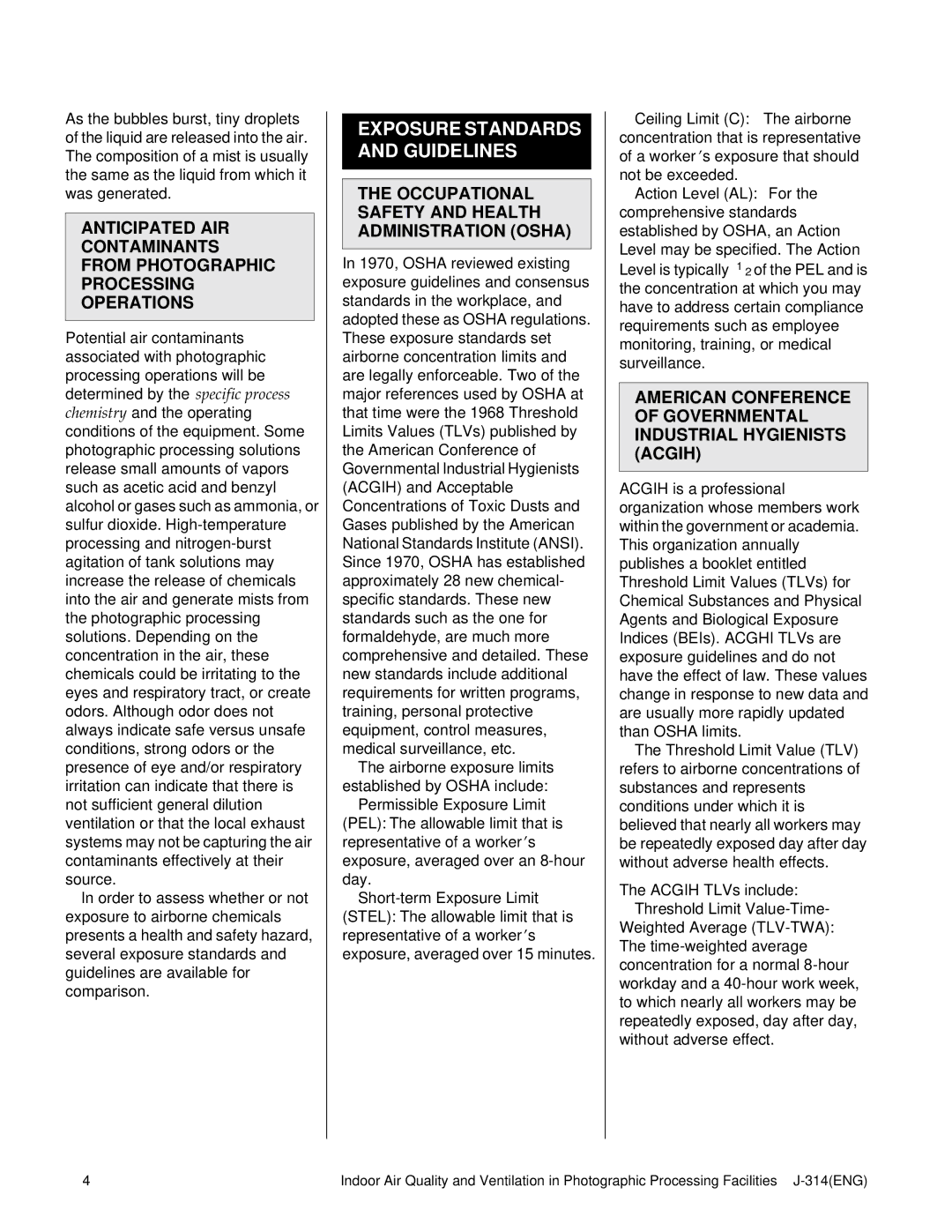
As the bubbles burst, tiny droplets of the liquid are released into the air. The composition of a mist is usually the same as the liquid from which it was generated.
ANTICIPATED AIR
CONTAMINANTS FROM PHOTOGRAPHIC PROCESSING OPERATIONS
Potential air contaminants associated with photographic processing operations will be determined by the specific process chemistry and the operating conditions of the equipment. Some photographic processing solutions release small amounts of vapors such as acetic acid and benzyl alcohol or gases such as ammonia, or sulfur dioxide.
In order to assess whether or not exposure to airborne chemicals presents a health and safety hazard, several exposure standards and guidelines are available for comparison.
EXPOSURE STANDARDS AND GUIDELINES
THE OCCUPATIONAL SAFETY AND HEALTH ADMINISTRATION (OSHA)
In 1970, OSHA reviewed existing exposure guidelines and consensus standards in the workplace, and adopted these as OSHA regulations. These exposure standards set airborne concentration limits and are legally enforceable. Two of the major references used by OSHA at that time were the 1968 Threshold Limits Values (TLVs) published by the American Conference of Governmental Industrial Hygienists (ACGIH) and Acceptable Concentrations of Toxic Dusts and Gases published by the American National Standards Institute (ANSI). Since 1970, OSHA has established approximately 28 new chemical- specific standards. These new standards such as the one for formaldehyde, are much more comprehensive and detailed. These new standards include additional requirements for written programs, training, personal protective equipment, control measures, medical surveillance, etc.
The airborne exposure limits established by OSHA include:
Permissible Exposure Limit (PEL): The allowable limit that is representative of a worker’s exposure, averaged over an
Ceiling Limit (C): The airborne concentration that is representative of a worker’s exposure that should not be exceeded.
Action Level (AL): For the
comprehensive standards established by OSHA, an Action Level may be specified. The Action Level is typically 1⁄2 of the PEL and is the concentration at which you may have to address certain compliance requirements such as employee monitoring, training, or medical surveillance.
AMERICAN CONFERENCE OF GOVERNMENTAL INDUSTRIAL HYGIENISTS (ACGIH)
ACGIH is a professional organization whose members work within the government or academia. This organization annually publishes a booklet entitled Threshold Limit Values (TLVs) for Chemical Substances and Physical Agents and Biological Exposure Indices (BEIs). ACGHI TLVs are exposure guidelines and do not have the effect of law. These values change in response to new data and are usually more rapidly updated than OSHA limits.
The Threshold Limit Value (TLV) refers to airborne concentrations of substances and represents conditions under which it is believed that nearly all workers may be repeatedly exposed day after day without adverse health effects.
The ACGIH TLVs include: Threshold Limit
Weighted Average
4 | Indoor Air Quality and Ventilation in Photographic Processing Facilities • |
